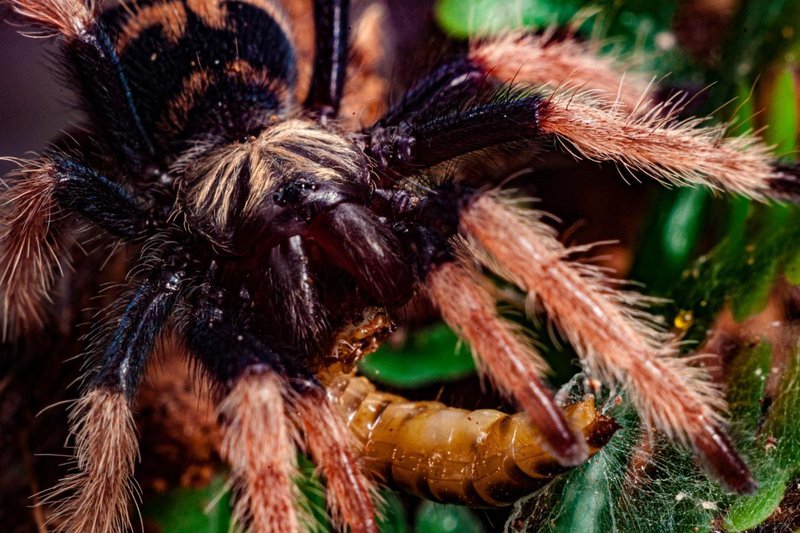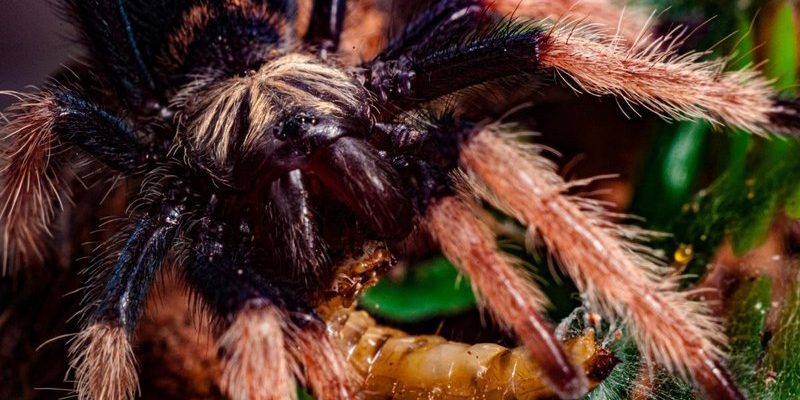
In the wild, tarantulas are opportunistic eaters, catching whatever prey happens to wander too close. This could mean insects, small rodents, or even other spiders. In captivity, though, their menu changes. You might find yourself tossing in crickets or mealworms instead of the varied diet they would feast on in the wild. Let’s dig into the specifics, comparing their eating habits based on their environment.
The Tarantula Diet in the Wild
In the wild, tarantulas primarily hunt and consume insects. Imagine being in the jungle, where these spiders lay wait, camouflaged under leaves or nestled in the earth. Their menu includes a variety of insects like crickets, grasshoppers, and beetles. When a meal approaches, these skilled hunters spring into action, quickly subduing their prey with a swift bite that injects venom.
But insects aren’t their only fare. Depending on the species and local ecosystem, small mammals, frogs, or even other smaller tarantulas can make it to the dinner plate. The type of tarantula can influence its diet as some species are larger and can take down bigger prey—like mice or lizards—while others may primarily stick to smaller insects. It’s all about the environment and what’s available.
Here’s a quick rundown of what tarantulas typically eat in the wild:
- Insects: crickets, grasshoppers, and beetles
- Small mammals: mice or small birds
- Other arachnids: smaller tarantulas can be prey
- Occasional frogs or lizards: depending on their habitat
Understanding Their Role As Predators
Tarantulas are more than just cute pets; they play a critical role in their ecosystems as predators. By controlling insect populations, they help balance the environments they inhabit. Imagine a world where insects run rampant; that would be a nightmare for crops and gardens alike! These spiders help keep those populations in check, turning them into valuable contributors to their ecosystems.
Interestingly, the hunting technique of tarantulas is quite different from other predators. They often don’t spin webs but rather use their speed and stealth to catch prey. This predatory behavior is key to their survival, as it dictates what they eat and when. It’s a dance of patience and precision, waiting for the perfect moment to strike.
The Tarantula’s Captive Diet
When it comes to keeping tarantulas as pets, their diet shifts significantly. Instead of hunting for their food, pet owners need to provide a steady supply of food that mimics what they would eat in the wild. So, what does a pet tarantula usually munch on? The primary offerings include crickets, mealworms, and roaches. These items are typically available at pet stores or can be raised at home.
Many tarantula enthusiasts also recommend offering pre-killed prey. This prevents any potential injury to your pet while still allowing them to enjoy a nutritious meal. Pet owners should aim for a varied diet, just like their wild counterparts, to ensure their tarantula is healthy and happy.
It’s essential to note that while tarantulas can often eat larger prey in the wild, in captivity, it’s best to stick with appropriately-sized food. Offering prey that’s larger than the tarantula’s body can pose a serious risk. It’s about maintaining a safe and enjoyable feeding experience.
- Crickets: a staple and easy to find
- Mealworms: nutritious and a good alternative
- Roaches: another excellent protein source
- Pre-killed prey: safest option to avoid injuries
Feeding Frequency and Amount
Feeding frequency can vary depending on the tarantula’s age and species. Generally, young tarantulas require food more often—sometimes every few days—while adults can thrive on a weekly feeding schedule. It’s like being on a diet; you need to adjust based on growth and activity levels.
Another critical point is the amount you feed your tarantula. Overfeeding can lead to various health issues, including obesity—yes, tarantulas can get chunky! A good rule of thumb is to offer a meal that’s about the same size as the tarantula’s body. This way, they can get the nutrients they need without excessive leftovers.
You might be wondering how to know if your tarantula is hungry. Watch for behaviors like actively searching around their enclosure or digging, which can signal hunger. A well-fed tarantula will be less active and more content in its habitat.
The Difference in Nutritional Content
The diet of tarantulas in the wild is diverse, providing them with a broad spectrum of nutrients. In contrast, the captive diet might lack some of that variety. This is where having a balanced feeding routine comes into play. Supplementing with vitamin powders or providing a variety of food sources can help mimic their natural diet.
For example, insects like crickets are high in protein, while mealworms provide fats. Rotating between different food types can help ensure your tarantula gets a well-rounded diet, preventing nutritional deficiencies that can crop up in a more limited feeding routine.
You might find that different species of tarantulas have unique dietary needs. Researching your specific tarantula species can guide you on the best food options and supplements.
Impacts of Captivity on Feeding Behavior
Being in captivity, tarantulas can exhibit different behaviors compared to their wild counterparts, especially regarding feeding. In nature, their hunting instinct drives them to actively chase prey, while in captivity, they might take on a more passive role. Often, they may wait for food to be placed in their enclosure rather than actively seeking it out.
This change in behavior might seem concerning, but it’s a natural adaptation. Captive tarantulas don’t have to expend energy hunting, so their eating habits can shift. It’s important for pet owners to keep an eye on these behaviors to ensure their tarantula stays healthy.
Also, some tarantulas can become picky eaters in captivity. If you find your tarantula refusing food, consider changing up the menu. Sometimes, offering different prey types or even the occasional snack can reignite their interest.
Whether in the wild or in captivity, understanding what tarantulas eat is critical to keeping them healthy and thriving. Wild tarantulas feast on a variety of insects, small mammals, and other arachnids, equipping them with a balanced diet tailored to their ecosystem. On the other hand, captive tarantulas rely on the careful choice of food provided by their owners, which should closely resemble their natural menu.
By ensuring your pet tarantula gets a varied and nutritious diet, you can help them thrive, fostering a healthy and happy life. So, if you’re thinking about bringing a tarantula into your home, remember—it’s not just about keeping them alive; it’s about feeding them well! Keep their diet varied, observe their behaviors, and watch them flourish as the unique and beautiful creatures they are.

